Criterium du Dauphiné: Deviating from the script during Tour de France audition
A curious cast delivered a fractured narrative at a race which may have raised as many questions as it answered
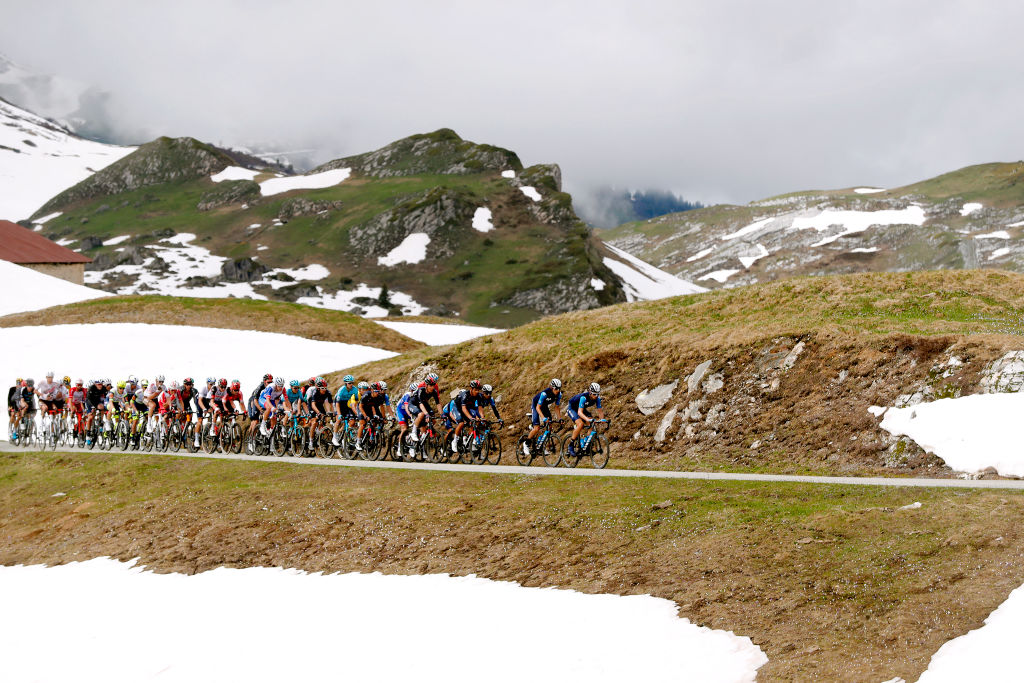
The Criterium du Dauphiné is always kind of insane. Last year, we saw explosive performances from the likes of Primož Roglič (Jumbo-Visma) and Wout van Aert (Jumbo-Visma), foreshadowing much of what was to come in the Tour de France that year, for the Dauphiné is rather like a kind of audition, a proving ground for the Tour, a who’s who of form and tactics.
This year’s edition, however, proved to be rather strange. In fact, strange things happened on every stage – from unlikely winners to unlucky second places – it’s hard to watch this race and not think 'what the hell is happening?'
Well, for starters, the race dynamic was a little odd because a lot of the big names from last year simply weren't there. Roglič and van Aert have been at training camp in Tignes; Tadej Pogačar (UAE Team Emirates) opted for the Tour of Slovenia; Thibaut Pinot (Groupama-FDJ) is MIA, and half of Ineos Grenadiers headed to the Tour de Suisse, while others were finishing off the Giro d’Italia.
And yet, because the Ineos roster was so incredibly stacked, it created a power vacuum not dissimilar to that which saw a podium sweep at Volta a Catalunya, and in fact, like that race, much of what can be analysed at the Dauphiné is which of the Ineos power duo, in this case Geraint Thomas or Richie Porte, would come out on top.
One got the sense when watching this Dauphiné, all eight stages of it, that many teams are treating it less as a stand-alone race and more explicitly like a training camp. After all, when one’s strongest riders are at the Giro, Tour de Suisse, or training at altitude, the most one could do is hunt for stage wins and hope for the best.
Still, there were some stories worth telling.
It’s rather uncommon in a week-long stage race to have back-to-back wins from the breakaway, and yet in this year’s Dauphiné that’s exactly what happened on the first two stages. A bit of context: just a few weeks ago Brent Van Moer (Lotto Soudal) appeared set to win the Ronde van Limburg from out front. He yo-yoed in the last ten kilometres of that race, his time back to the bunch fluctuating from more than fifty to down to just twelve seconds, and yet, as the compact, modern townhouses of Limburg rose up around him, it still looked as though he was going to make it, barely, by the skin of his teeth.
Get The Leadout Newsletter
The latest race content, interviews, features, reviews and expert buying guides, direct to your inbox!
It was the kind of making it where the tension is so incredibly high that one can’t help but scream come on, come on, come on, as the metres tick down. Then, in the final kilometre, something happened, and the camera panned to Van Moer slapping his handlebars in frustration. It’s heartbreaking, really – he’d taken a wrong turn, perhaps the most embarrassing defeat possible.
Surely, this was all on his mind as Van Moer gave every last ounce of himself in the last ten kilometres of the first stage of the Dauphiné, as soloed off at the front, absolutely digging into the pedals. He was out for a while, but the sub-one-minute time gap meant that Van Moer couldn't stop now, under no circumstances could he stop. Would his pursuer, Felix Gall, the Austrian from DSM, and the peloton behind risk everything on what is shaping up to be a long descent on tricky, narrow roads to try and pull back some Belgian kid?
It’s a gamble of safety and time, and on that day, the peloton chose safety. Gall was pulled back, but Van Moer’s 50 second time gap manages to stick as the kilometres tick down: ten, five, two, then it’s twenty-five seconds, but no matter. This time, he really was going to make it. When he crossed the line, he found redemption, and Van Moer’s first ever WorldTour stage win, finally, was secure.
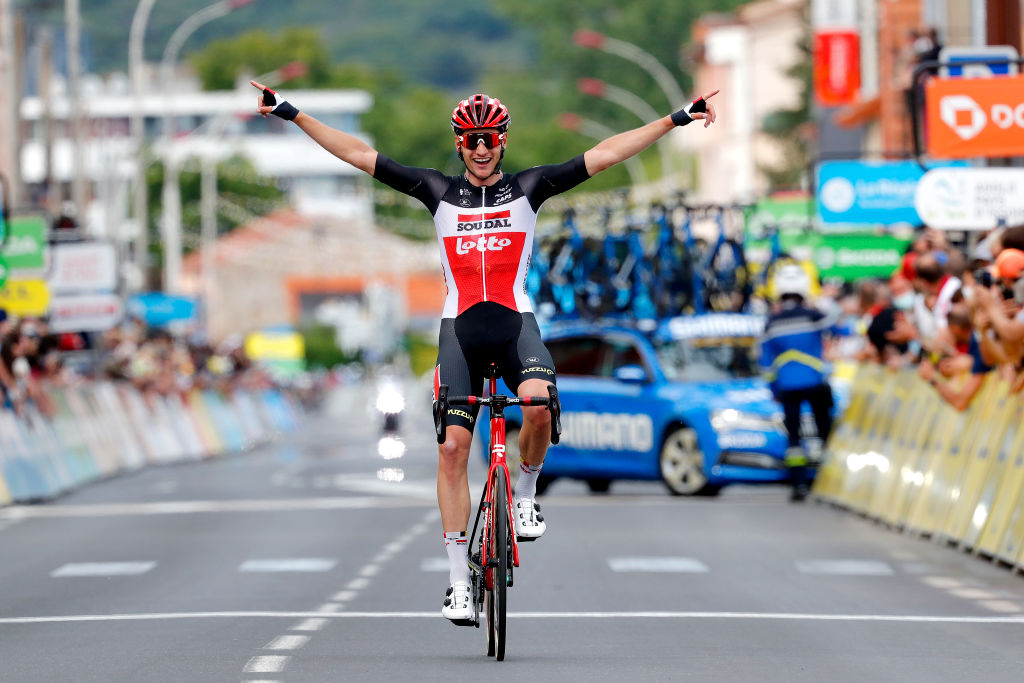
Lifting Colbrelli's curse
A side narrative of this tale was that of Bahrain Victorious’ Sonny Colbrelli, a sprinter known for his second places in stage race sprints, a curse he finally seemed to have broken back in Tour de Romandie where he won twice. However, in the Dauphiné, Colbrelli would once again get second two stages in a row. On the second stage, it was Bora-Hansgrohe’s Lukas Pöstlberger who managed to hold him off from the breakaway with eleven seconds to spare, an almost exact replica of what Van Moer did on the first stage.
This must be rather frustrating for Colbrelli, for he had managed to hold out over the rolling hills that have marked the first two stages, hills that would take out most sprinters handily, but Colbrelli is a rather unusual case in that he seemed to have found his climbing legs back in the mountains of Switzerland.
The third stage, however, was made for him. It was pan flat so there’s no way some kids in a breakaway are going to use the climbs and the descents to put time into what has seemed to be a rather relaxed peloton given the prestige of the race – the kind of peloton one sees in certain stages of grand tours on days before massive climbs that will prove decisive for the general classification.
Why not let the break go on days like that? However, there are 21 stages in, say, the Giro d’Italia, but only eight in the Dauphiné – surely someone, somewhere in the bunch, was hungry for victory. Stage 3 was the only true flat stage in the race, and all the teams that have brought a sprinter wanted a chance at it.
However, surprisingly, the men Colbrelli was fighting in the final sprint were not sprinters, but GC men – the likes of Alejandro Valverde (Movistar) and Brandon McNulty (UAE Team Emirates), men who are fast but who are by no means bunch sprint specialists. Perhaps this is why he was able to hold them off at the line, doing so in resplendent fashion. Perhaps, deep down, after two second places in a row, he just wanted it more.
It starts to get weird
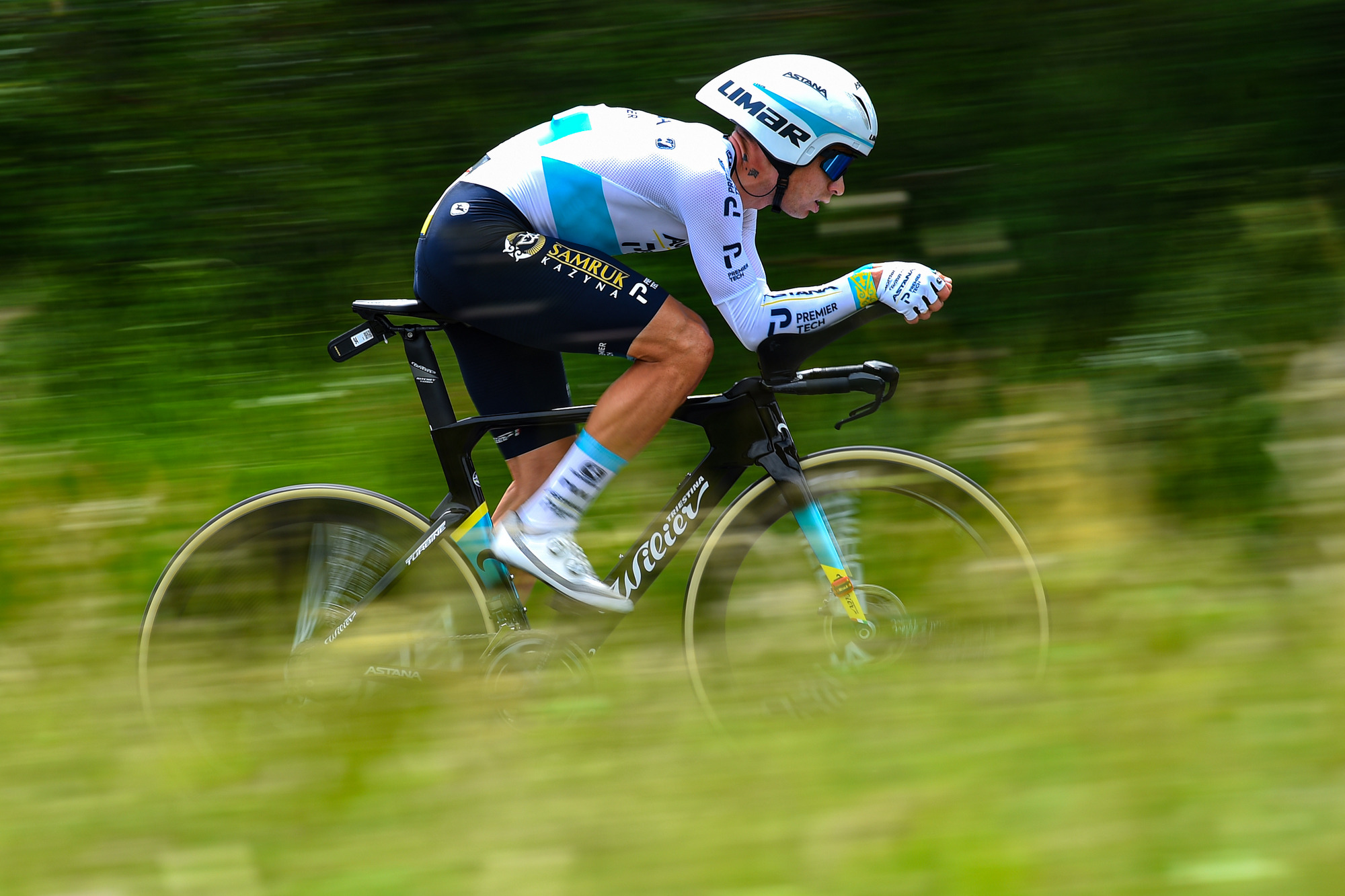
The time trial, stage 4, was when things start to get, well, a little weird. With two breakaway wins and a bunch sprint already done, no GC contender had been established, which created a fascinating dynamic for watching a time trial. The test was short at only 16.4 kilometres, but almost all of that was spent battling over rather nasty hills. Those are the kind of time trials one expects a Thomas or McNulty or a Steven Kruijswijk (Jumbo-Visma) to excel – the kind of time trial that can prove decisive in that it reveals who amongst the top contenders appears strongest, rather than in creating big time gaps.
Were it at the end of the race rather than in the middle, it could definitely determine the distance between failure and safety. One truly expected Ineos to walk away with this – with the likes of Porte and Thomas, it was entirely within the realm of possibility for an Ineos one-two. Yet, surprisingly, at the end of the day, neither were in even the top five. It was Jonas Vingegaard of Jumbo Visma who spends most of his time in the hot seat before being usurped by Porte, who we expected to see linger there for a while – but he doesn’t. In fact, he was evicted rather quickly.
Now, it’s not unheard of for the likes of Astana-Premier Tech’s Alexey Lutsenko to do well in a time trial – he places in the top twenty with relative frequency. However, he’s never won against the clock at the WorldTour level, not once. He hasn't finished in the top 10 at this level since 2014, in fact. To put it bluntly, in stage 4 of the Criterium du Dauphiné, Lutsenko rode the time trial of his life.
Not even his teammate and arguably the better rider against the clock, Ion Izagirre, could beat him. Lutsenko wasn’t alone in surprising, however – the race’s then yellow jersey holder, Pöstlberger managed to ride into the top ten, and Ilan van Wilder, Team DSM’s young Belgian talent, secures a place in the top five. It was a strange day, with unexpected winners.
Does this mean that teams like Jumbo and Ineos were weak and Astana strong? It’s hard to say. The time gaps were still too close to call for many of the GC men. Perhaps we’re just so used to seeing certain teams dominating that to see Astana do so for the first time this season feels odd. The Tour is less than a month away now, and the uphill time trial must leave a bad taste in the mouth of those who plan to contest it.
Richie Porte or Geraint Thomas? Geraint Thomas or Richie Porte? This is the question the Ineos Grenadiers had to ask themselves. The spoils were there for the taking, the team, though weaker than in other offerings throughout the year, was still for the most part stronger than those other competing teams simply because the Ineos Grenadiers’ roster was chock full of Grand Tour contenders and winners – they’ve got plenty to spare even across a calendar stretched this thin. That’s why, on the hilly but not terribly brutal fifth stage, Ineos were definitely in control.
Back to tradition
Day five starts off with a breakaway, however, that breakaway was poisoned by the presence of one Kasper Asgreen (Deceuninck-QuickStep), a man sat third on GC and also the winner of, you know, the Tour of Flanders from a breakaway. No one wanted to let Asgreen go, and it’s Bahrain Victorious who did the hard labour of pulling him back on behalf of – you guessed it – Colbrelli.
New breaks try to form after that point, but the peloton had just about enough of the breakaway’s antics, and so, it was Ineos who said no more. Here’s why: with 42 kilometres left to go, the race entered a flat and exposed section on which the potential for deadly crosswinds loomed. Ineos Grenadiers would've rather liked to have split the peloton in such a decisive meteorological scenario and they would very much not like to get caught out should others try something funny. The crosswinds split doesn’t come to fruition because, frankly, everyone else has the exact same idea. It’s would come down to the final climb.
Here’s the thing, EF Education-Nippo’s Lawson Craddock really wanted to win a stage of the Critérium du Dauphiné. He tried furiously over the next three days to do so. One wondered why this particular race is so important to him, but perhaps he was thinking he had a shot, given the field was conservative enough to let the likes of Pöstlberger or Van Moer go rather than risk doing anything that could lead to a crash this close to the Tour.
Day five was the first day he attacked on the final climb with 12.7 kilometres to go. His gap was never really that big, hovering around twelve seconds, and he’s not the most talented descender, but still, it takes the peloton ten kilometres to pull him back. Oh well, he thought, with that particular kind of American optimism, tomorrow would be another day. At that point in the race, with six kilometres to go, Sonny Colbrelli fancied another victory, and if he were to finish along with the the GC men he was almost certain he could dispose of them in the final sprint. His team did a pretty good job at keeping control of the peloton, however there’s one team that just so happened to be smarter on the day.
It was a tactical masterclass. At 1.4 kilometres to go, Ineos took control of the peloton away from Bahrain, led by Michał Kwiatkowski, who did a good job keeping an eye on his competitors and keeping Thomas in his wheel. Ineos knew that just after the flamme rouge lay a rather nasty hairpin turn, the perfect opportunity to put distance into the likes of Colbrelli, thereby holding him off. As soon as he hit the apex of the corner, Thomas launched, sprinting out of it, and immediately opening up a gap while Kwiatkowski maintains his speed and thereby slowed down anyone who would want to pursue.
Bahrain had to chase, and this wasn't ideal for them, because it means that they'd have to deploy the sprint far earlier than they want to. Despite this, Colbrelli hammered it home in the last 100 meters and, for a second it looked like Thomas would certainly be caught. It was a photo finish, but after the replay, it was clear that he had taken the spoils and Colbrelli would have to settle for yet another second place, as is tradition.
What's going on?
Stage 6. Alright, the likes of Pöstlberger and Colbrelli have had their little bit of fun, but there was still a race to win, and riders running out of days to win it. It was on stages like this, stages with four back-to-back climbs, that people start to speculate about the Tour. Lutsenko was finally in the yellow jersey while Porte and Thomas were looming in the GC. Jumbo-Visma had yet to walk away from this Dauphiné with anything, which, after their rather lackluster Giro, must have had them feeling sore.
And then, there was Movistar, but before there was Movistar, there was Craddock, flying off the front with 20 kilometres still to go. Yet again he tried, but he must've know by then that he'd missed his chance to pull the wool over the eyes of the peloton. Still, he was out there for quite a while, staying out all the way until the last three kilometres. Sometimes, things just come down to the bunch.
David Gaudu (Groupama-FDJ) was the first to set things off on the final climb. Tao Geoghegan Hart (Ineos Grenadiers) had a dig, then Sepp Kuss (Jumbo-Visma), but at the end, it was 41-year-old Valverde who took the spoils in the reduced sprint, his Movistar teammate Enric Mas finishing fifth.
Things in this race were starting to feel unsettled. What was going on? No Ineos on the virtual podium? Were Jumbo basically dead? Alejandro Valverde was still contesting mountain-top sprints? We were no clearer about the winner of this race than we were at the beginning – the time gaps separating first and sixth place remained within a 20-second margin and there were only two stages left.
However, 20 seconds can easily be taken back in the high mountains, which the race organisers had saved for last. If you thought this race was weird now, just wait – it would get even weirder.
A fractured narrative
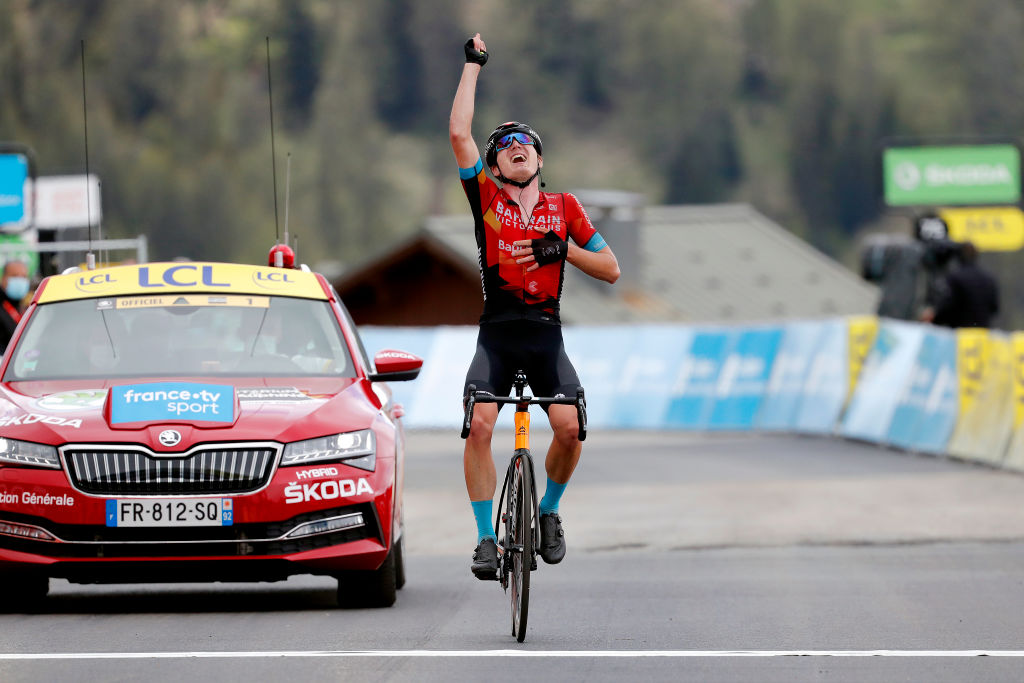
The selection by the end of stage 7 was elite, the likes of Porte, Thomas, Nairo Quintana (Team Arkea-Samsic), Mas, Kuss, Guillaume Martin (Cofidis), Kruijswijk, Valverde and Miguel Ángel López (Movistar). However, there were some less heralded players in the mix. Ben O’Connor (AG2R Citroën Team), Jack Haig (Bahrain Victorious), but most surprisingly, the young Ukrainian rider, Mark Padun.
In the last ten kilometres, those contenders were whittled away. Martin dropped first, followed by Kruijswijk after a dig by Valverde, who let go soon after. By the time there were 8 kilometres to go and a group had ventured off the front, it was Porte, Mas, Kuss, and Padun. Quintana, meanwhile, had relinquished himself to gravity. On the lush, verdant slopes of the final climb, the air thin in their lungs, Padun and Kuss attacked. They pulled out thirty seconds, but Kuss couldn't hold it. He gave way to exhaustion three kilometres later, pedalling squares. Padun was left all alone.
Behind, there were attacks and people try to bridge, and it was messy, but at the front, Padun’s advantage went out to a minute. Kuss was in no man’s land. At three kilometres to go, O’Connor, Haig and López reconnected with Mas and Porte, who was then a shoo-in for virtual yellow with Lutsenko already almost a minute behind. At some point, Mas dropped too.
Everything was so fractured that it was difficult to get a sense of who was where on what switchback, who had been dropped and who was trying to bridge. In the chaos, Padun crossed the line victorious and ecstatic, punching the air – the very definition of an unlikely winner. Porte sprinted to second, followed by López, Haig, and O’Connor. Kuss has sunk like a stone to sixth. Things really didn't look good for Jumbo-Visma.
When Padun won the first time, everyone was very happy for him. When he replicated the result the very next day, finishing 1:36 ahead of Jonas Vingegaard (Jumbo-Visma) on an even more difficult parcours, people started to scratch their heads, though there was nothing concrete to point fingers at other than what is a rather unsatisfying ending to a race that never really got going, narratively speaking.
Usually in races like the Dauphiné, with competition that seemed on its face rather open, fun things happen. Take the Tour of the Alps, which, with its win by Simon Yates (Team BikeExchange), truly served as a righteous prequel to the Giro, or Tour de Romandie, won by Thomas after a rather embarrassing crash, or even the Volta a Catalunya, whose Ineos podium sweep still had exciting stages that saw the return to form of widely-beloved riders such as Esteban Chaves (Team BikeExchange).
This race had, well, none of that. It was nice that Van Moer and Pöstlberger found success in the breakaway. It was nice that Colbrelli redeemed himself from second place once more. It was even nice that Padun secured that win on stage 7.
However, the longer the Dauphiné went on, the more narratively fractured it seemed. There was no inter-team power struggle between Porte and Thomas, who finished first and third on GC respectively – once it was clear Porte was stronger in stage 4, Thomas was allowed to go for a rather satisfying stage win.
Meanwhile, Lutsenko just kind of held on to second after that victory in the time trial. Half of the race felt less like a fight for victory than a fight to simply be in form. When the likes of Kruijswijk or Mas dropped, no one was too keen to bring them back, because hell, there’s always tomorrow. This Critérium du Dauphiné tells us more about what might happen in the Tour de France than it does a satisfying story in the way stage races – including all of the ones which have transpired this year – usually do.
Conclusions or questions
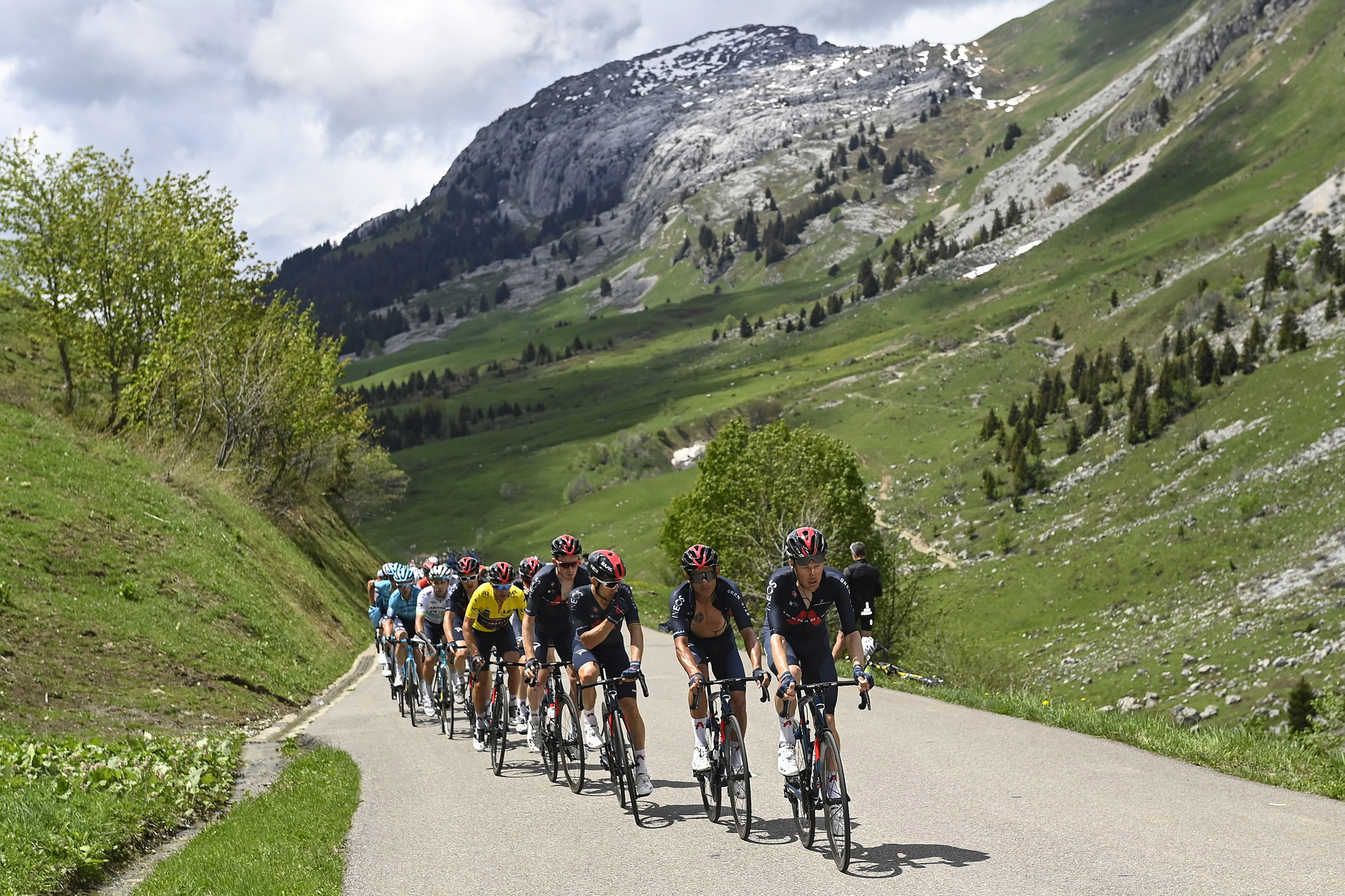
Still, some things going into the Tour are certain: Ineos Grenadiers has by far the strongest team in the peloton with riders to spare. Its Tour line-up feels rather like riding on an industrial lawnmower when the rest of the teams are still using machetes. There are, of course, other strong teams – Astana, Movistar, and Bahrain Victorious both proved mighty in this race – plus individual contenders like Wilco Kelderman (Bora-Hasgrohe) who also seem to be riding into form. However, what the Dauphiné has demonstrated better is who’s showing weakness.
Seemingly gone are the days of the all-powerful Jumbo Visma train, for example, and some teams like Groupama-FDJ, Cofidis, BikeExchange and Trek-Segafredo barely made their presences felt at all. Most importantly though, this race was thoroughly defined by the absence of so many riders who are just elsewhere right now. It truly goes to show that while cycling is a massive, sprawling sport, it absolutely has its main characters, and almost none of them were here. A play can’t really take off with just supporting roles, and perhaps that’s why this one kind of flopped.
Thomas and Porte and Lutsenko are great bike riders, but it takes more than some solid GC men to make a race worth watching. The concurrent Tour de Suisse is already more exciting in its first few stages than the Dauphiné was for its eight day duration, simply because more guys are there.
Mathieu van der Poel (Alpecin-Fenix), Marc Hirschi (UAE Team Emirates), and Julian Alaphilippe (Deceuninck-QuickStep) are all there. These are the types of punchy, dynamic recurring characters who light up a race time after time, seemingly just for the fun of it, all while the more stalwart GC men like Richard Carapaz (Ineos Grenadiers), Marc Soler (Movistar), and Michael Woods (Israel Start–Up Nation) battle it out in sometimes more subtle ways.
However, the most notable absences are the two Slovenians, Primož Roglič (Jumbo-Visma) and Tadej Pogačar (UAE Team Emirates), whose drama last year remains the centre of the commentators’ filler talk no matter what race one watches. Even when they are gone, they remain omnipresent.
Did we learn something from the Criterium du Dauphiné? Of course. And yet, for every answer of form, of team power, of the future, until that fated day in Brest, there will always be room for more and more questions.
Kate Wagner is a Chicago-based writer and critic. Her work on cycling can be found in various publications including Procycling. Her newsletter covers cycling in an unconventional fashion, featuring essays, short stories, multimedia works and illustration.
She can be found Tweeting at @derailleurkate